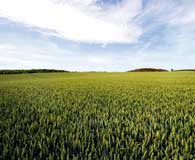Direct drilling helps cuts wheat carbon footprint

One way to cut the carbon footprint of producing top-quality milling wheat is to sell off a big chunk of your diesel-devouring farm machinery.
Andrew Bott took the plunge in September 2011, declaring annual cultivations out of date. He cleared his farmyard of expensive machinery and took up direct drilling.
He loaded up his big 200hp tractor, cultivator, plough, press and subsoiler to send back to his machinery dealer and in its place came a John Deere direct drill and a GPS system.
Two years on, he says his soils are getting better and better, there’s more earthworm activity and his diesel tank doesn’t empty so readily.
Mr Bott had already banished the plough more than a decade before and embarked on a minimum tillage regime in 2000, but with the help of Sainsbury’s he is aiming to cut his energy use further.
The supermarket chain is looking to cut its own carbon footprint and as a grower of milling wheat for the group’s in-store bakeries, Mr Bott was keen to do his bit to help.
“The less you can disturb the soil, the better. The Holy Grail of a no-tillage system is to build up the organic carbon in your soils,” he says.
He chairs the Sainsbury’s Wheat Development Group, which is a small band of 20 farmers drawn from the 300 or so Camgrain members that supply the retailer and who are keen to cut their farming carbon footprints.
Selling off a big part of his farm machinery cut Mr Bott’s costs dramatically, and his fuel consumption for drilling and cultivation fell to 7 litres/ha from 20 litres/ha under minimum cultivation.
His total fuel costs now make up 4% of his carbon footprint, compared with 8% previously, but both figures are shaded by the 80% for fertiliser, both from manufacturing and losses in the field.
He farms 600ha of chalky soil with clay caps in Hertfordshire, just east of Stevenage, and a number of his neighbours have also taken the no-ploughing approach.
He grows about 430ha of combinable crops at his Finches Farm in Benington, including winter wheat, barley and oilseed rape, and also spring barley, beans and linseed.
The autumn of 2011 was an ideal time to venture into a no-tillage system, with an early harvest and dry seed-beds, but last autumn brought a host of problems.
His wheat struggled in cold and wet conditions and the chopped straw trash left by the combine did not release enough nitrogen to feed his fledgling plants.
Mr Bott finds slugs do not like no-tillage conditions, as there is less shelter to be had compared with soft newly-worked earth, but the wet, mild spring created ideal breeding conditions and they were out in force.
In hindsight, he believes he should have applied some nitrogen to the seed-bed to counter such poor growing conditions and used a straight-tined stubble rake to keep slug numbers under control.
“The no-till approach clearly needs better management and a degree of flexibility,” he says.
However, he has had success in controlling slugs by broadcasting a cover crop of mustard, buckwheat and vetches just before harvest and then drilling wheat into this subsequent green crop.
The slugs prefer to eat the green crop rather than the newly drilled seed, and in addition the green crop keeps the soil in good condition and the lush cover crop maintains the drill’s coulters free of mud and stones.
The green cover crop is sprayed off with glyphosate just before or straight after drilling.
This approach may help him eventually reduce the overall fertiliser needs of his crop, especially when it is left to grow longer over the winter to be followed by a spring crop.
This year he is growing 100ha of Solstice wheat for milling and 112ha of Scout for feed wheat, and normally the extra cost of growing milling wheat is covered by the milling price premium.
Milling wheat receives 240kg/ha of nitrogen with 40kg/ha at the flag leaf stage in May compared with 180kg/ha for the feed wheat, although his future aim is to grow bread wheats with less fertiliser.
Last harvest, he struggled to meet the milling specification of 13% protein, 250 Hagberg and specific weight of 76kg/hl, with proteins slipping to 12% and specific weights to 72kg.
This is where Camgrain works for him, as it is able to blend milling wheats from its members to meet the Sainsbury’s milling specification.
He admits that his is not the best wheat land, with average yields of 8.0-8.5t/ha, but the past two harvests have been down to 6.5t/ha, with 2011 hit by drought on his light soils and 2012 affected by wet weather at harvest.
Still, he is convinced his soils are in better health with his chalk outcrops looking less white, a clear sign of increased soil organic matter.
“With a no-till system, the aim is to get excellent soil biology, and despite a difficult time last autumn, we are making progress,” he says

